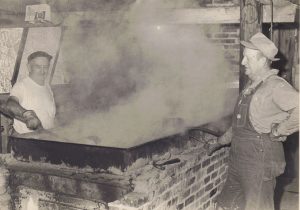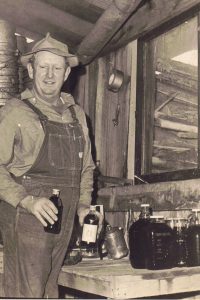Because it’s getting to be that time of year, I have a throw-back subject – making maple syrup. When I met my husband and when we were first married, his family made maple syrup. And I mean they MADE maple syrup – it wasn’t a small operation – they tapped up to 600 trees. They stopped for a couple reasons: it was a labor-intensive operation, and as the boys started leaving home, the labor dried up; and FDA regulations changed, making the home business more difficult to maintain. I have to admit, I still miss it and I regret that my children didn’t get a chance to experience this part of farm life. We still have the old sugar camp building (in shambles) and all the equipment, but sadly, we don’t have the labor, either, and although there are ways to make it less labor-intensive, setting it up would be expensive.

Maple syrup season lasts for just a couple weeks in late February or early March – when the ground is freezing and thawing nightly. The work starts much earlier, cutting and splitting wood for the wood-fired furnace. Yep, that’s my younger husband, splitting wood at the sugar camp. He’s got some serious wood splitting skills – no wood splitting machines back then. His dad was good, too. Did I mention that this was a labor-intensive task?

When the weather is right and the sap starts flowing, it’s all hands on deck, tapping trees. This is my husband and his grandfather, showing the new way of collecting sugar water (blue plastic bags that inhibit spoilage) and the old oak bucket.

Each morning, one or two of the boys would go out with the tractor and a 350-gallon tank and empty the sap bags. A big tree can produce as much as 45 quarts of sugar water, and a smaller one will produce a gallon or more. On a good day, they would collect 1000-1200 gallons of sugar water. The water was transferred to a tank inside, and the boiling would begin.

Oh, my, the sweet, sticky air inside the sugar camp was indescribable. The sugar water boiled for hours, because it takes 50-100 gallons of sugar water to make a gallon of maple syrup. It varies depending on the weather — in a good season with a lot of freezing and thawing, the sap contains more sugar than in a year when the weather is more consistent. You can get an idea of the level of sugar in the sap by the color of the syrup — a lighter color indicates that the sap had more sugar — a darker color required more boiling to get it to the right consistency. Although you can’t see them for the steam, the pan had several sections, with the sugar water initially poured into the back section and then transferred from one to another as it boiled down. The water in the last section (the left third of the pan above) was watched closely, with syrup being scooped out and tested with a hydrometer to determine when it was ready to be pulled off and bottled. In this picture, my husband’s grandfather is scooping some out to test. As it got near the end of day, we would quit adding fresh sugar water until most of the syrup could be drawn off, then the pans would be refilled and the fire banked for the night. By the next morning, a new batch would be ready to draw off.

The finished maple syrup was drawn off and poured through a thick felt filter, and then bottled in various-sized bottles. A plastic seal around the neck of the bottle shrunk as the syrup cooled to provide a good seal. Although she didn’t spend much time in the sugar camp, my mother-in-law also got involved, boiling some of the water down farther in her kitchen to make maple sugar candy. Yum!
And of course, just because everyone was busy making syrup didn’t mean that the farm work quit, there were still cattle, sheep, and hogs to feed, animal babies to take care of, and a Guernsey cow to milk twice a day (by hand). It was a tiring couple of weeks, but so worth it. Sometimes when I drive by the old sugar camp, I can still smell the boiling sugar water.